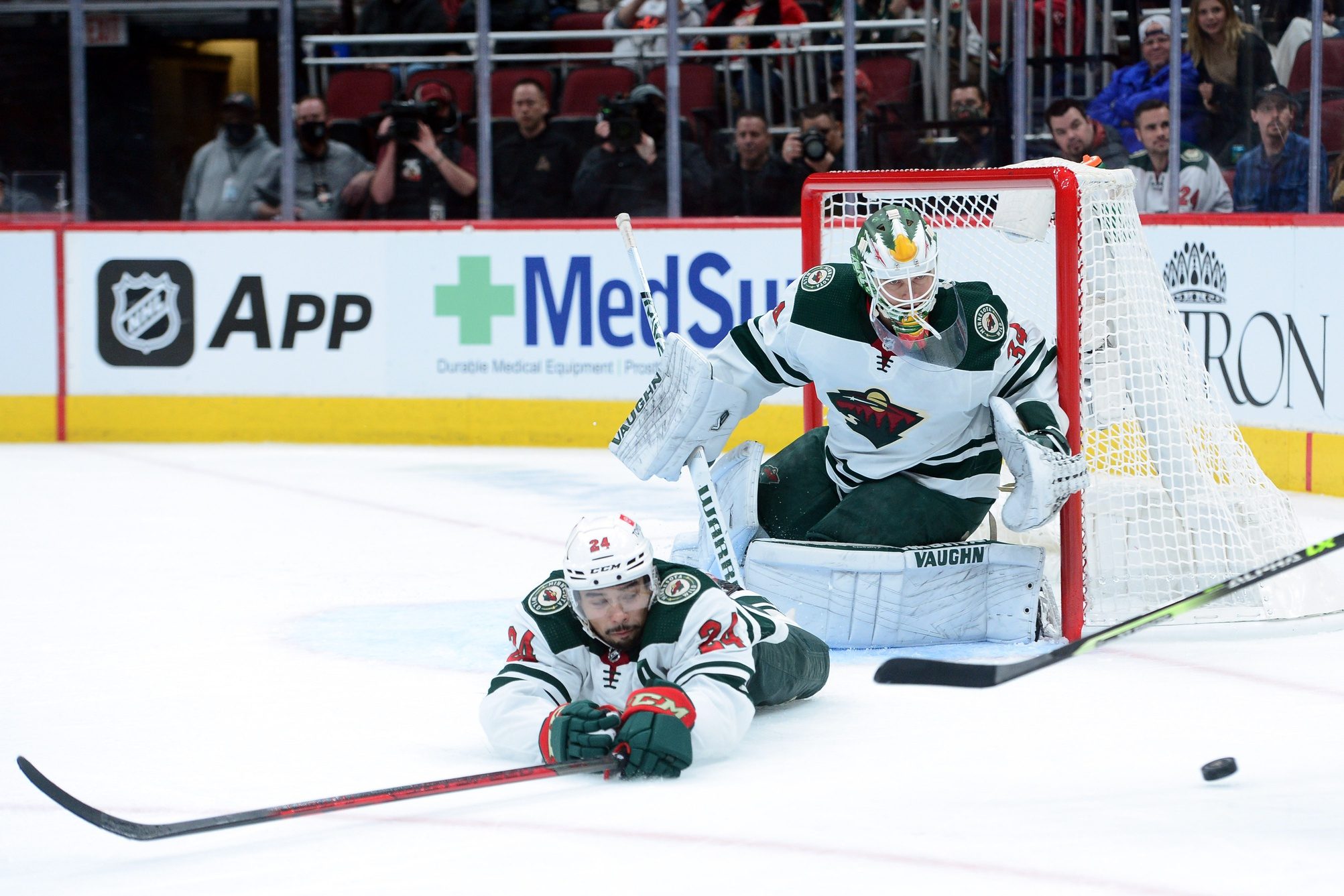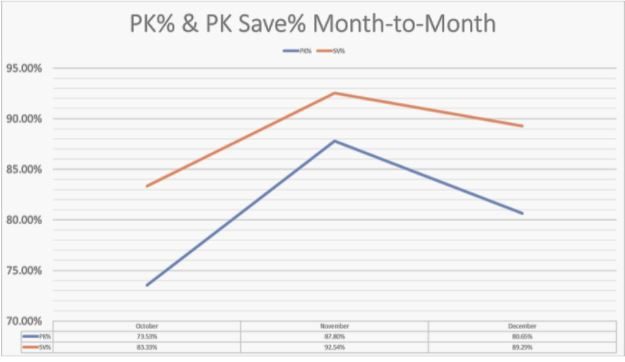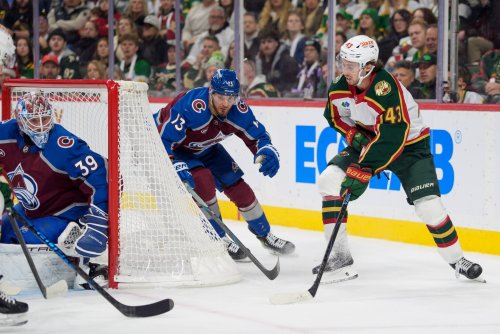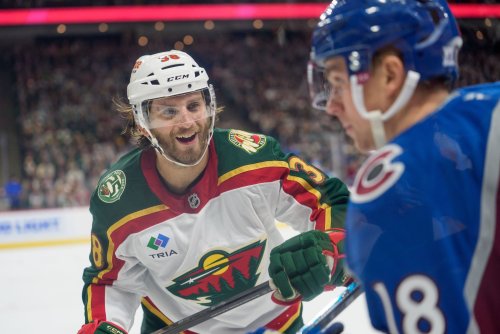
The Minnesota Wild is used to being in the mushy middle. Never good enough to contend, but not bad enough to tank either. It’s made for some compelling seasons where they look great and primed for a deep playoff run or others where they might fall out of the postseason race altogether. That hasn’t been the case for Minnesota this year, though. They rank highly in goals scored, goals scored above expected, and have maintained average defense after injuries pulled prominent top four defensemen out of the line-up.
Special teams remain an issue for Dean Evason’s Wild. But with the addition of Matt Boldy and his puck-moving abilities, the power play has a chance to start trending upward. However, the penalty kill remains stuck in that mushy middle. It’s mediocre at best. When healthy, the PK can feature strong defensive forwards and elite defensemen. Yet, at this point in the schedule, there’s enough of a sample size to prove that the Wild are what they are – a 16th ranked penalty-killing team.
Recently, the PK impacts could be attributed to the injury to Minnesota’s best two-way forward, Joel Eriksson Ek, throwing the forward groups into a whirlwind. Or it could be the long-term loss of Jared Spurgeon, and more recently, Jonas Brodin. Certainly, losing the defensive acumen of both players for an extended time is dampening the Wild’s ability to kill off penalties effectively.
But as the adage goes, a team’s goaltender must be the best penalty killer. And, frankly, the Wild’s goaltending has been average. It’s capable of getting hot and looking like it’s poised to backstop the team to a deep playoff run. But it also can be so milquetoast that it might force GM Bill Guerin’s hand to upgrade at the position.
It would appear that the penalty kill has been as up and down as injuries have played out. However, according to NaturalStatTrick.com, Wild skaters have been pretty consistent in terms of expected goals allowed on a month-to-month basis.
| xGA by Month | |
| October | 7.21 |
| November | 7.73 |
| December | 6.43 |
Have injuries played a part in Minnesota's lackluster performance on the penalty kill? Sure. But not to the degree most think. As much as the Wild has changed their approach on offense to create more puck movement and more scoring chances, the remnants of Mike Yeo's defensive structure and Bruce Boudreau's defensive aggression still linger. Minnesota hasn't forgotten how to play defense no matter who the coach or GM is. That high standard on defense looks to have been passed on to newcomers Dmitry Kulikov, Jon Merrill, and Jordie Benn.
That leaves us with the goaltenders. As they have gone, so has the Wild’s PK. Compare Minnesota's shorthanded save percentage with the penalty kill's conversion rate, and the correlation is obvious.

When the Wild have needed their goalie to be at their best, both Cam Talbot and Kaapo Kahkonen have been more of a roller coaster than anything deserving of an All-Star nod.
The Wild can ill-afford to go into the postseason with an average PK. Special teams as a whole need to improve, but Minnesota can’t give their opponents extra goals while shorthanded. The Wild are a good, maybe even great, team at 5-on-5. They can control the pace of the game to their liking at even strength as well as some of the best teams in the NHL. Wins over the Toronto Maple Leafs and Edmonton Oilers earlier this season showed that they could play with anyone.
So outside of trading for a goalie or suddenly never taking penalties again, Minnesota should change things up on the PK to help the goalies out. 10K Rinks has talked before about using a modern “power kill” approach to feature its best stars more often. We've also suggested that the Wild be aggressive on the PK while the other team is trying to break out of their zone. Minnesota's passive, conservative approach puts the focus squarely on the goaltending’s shoulders.
The Wild could stand to replicate some of the best penalty-killing teams in the league. The Carolina Hurricanes and Pittsburgh Penguins lead the NHL with 90.5% and 90.3% PK conversion rates – the only two teams to break the 90% mark. Teams ranked third through six are:
New York Rangers | 85.6%
Anaheim Ducks | 84.8%
Calgary Flames | 84.2%
St. Louis Blues | 83.7%
Three of those top six penalty-killing teams also rank one, two, and three in Shots For % while shorthanded. Every team in the NHL will be giving up the majority of the shots on goal down a man. But what those three teams – Hurricanes, Penguins and Blues – can do is take a significant portion of the shot share away from the team that is supposed to be on the man-advantage.
Carolina effectively flips the script while shorthanded. Most teams have given up roughly 200 shots on goal when killing penalties at this point in the schedule. Not only have the Hurricanes allowed the third-fewest shots on goal with 125, but they’ve taken 50 shots on goal themselves. They keep the puck away from their net by keeping it in the offensive zone, reducing the number of shots their goaltenders see when the team is decidedly disadvantaged.
This strategy doesn’t always translate into shorthanded goals. Both Pittsburgh and Carolina have just two shorties to show for playing so aggressively. The point of that kind of strategy isn’t always about scoring but more about putting pressure on the other team 150 feet away from your goalie. On the other hand, St. Louis is tied for the league lead with six shorthanded goals. By playing an aggressive style, shorties are a way to crush a team trying to make a comeback or swing the momentum. Compare that with the Wild’s one shorthanded goal. Coupled with Minnesota's conservative and porous PK, the Wild are taking the “L” more often than not.
In the playoffs, the Wild should look for any advantage they can get. With the players they have, they have the talent on the roster to make this happen. It comes down to mindset and approach. The current strategy is to clear the puck, get a quick line change, and continue the passive penalty kill until the two minutes are up. It’s a responsible strategy, if not boring. However, it’s also decades old. Evason has been able to evolve during 6-on-5 situations, something Mike Yeo wouldn’t think of a decade ago. But strangely, Evason is holding on to a very Yeo-esque PK, and Minnesota isn't any better for it.
It’s time to unleash the Wild penalty killers. Let them put on the full-rink press and do what those players do best – work in transition. Doing so should take some of the pressure off the goalies in shorthanded situations. If it improves the goalie play even just a little, perhaps Guerin can make a swing at the trade deadline for a center rather than shoring up the goaltending.
Think you could write a story like this? Hockey Wilderness wants you to develop your voice, find an audience, and we'll pay you to do it. Just fill out this form.







Recommended Comments
There are no comments to display.
Join the conversation
You can post now and register later. If you have an account, sign in now to post with your account.
Note: Your post will require moderator approval before it will be visible.